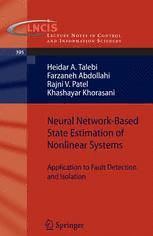
Neural Network-Based State Estimation of Nonlinear Systems: Application to Fault Detection and Isolation PDF
Preview Neural Network-Based State Estimation of Nonlinear Systems: Application to Fault Detection and Isolation
Lecture Notes in Control and Information Sciences 395 Editors:M.Thoma,F.Allgo¨wer,M.Morari Heidar A. Talebi, Farzaneh Abdollahi, Rajni V. Patel, Khashayar Khorasani Neural Network-Based State Estimation of Nonlinear Systems Application to Fault Detection and Isolation 123 SeriesAdvisoryBoard P.Fleming,P.Kokotovic, A.B.Kurzhanski,H.Kwakernaak, A.Rantzer,J.N.Tsitsiklis Authors HeidarA.Talebi FarzanehAbdollahi DepartmentofElectricalEngineering DepartmentofElectricalEngineering AmirkabirUniversityofTechnology AmirkabirUniversityofTechnology 424HafezAve. 424HafezAve. 15914Tehran 15914Tehran Iran Iran [email protected] f [email protected] RajniV.Patel KhashayarKhorasani DepartmentofElectrical&Computer DepartmentofElectrical&Computer Engineering Engineering UniversityofWesternOntario ConcordiaUniversity 1151RichmondStreetNorth 1455MaisonneuveBlvd. LondonONN6A5B9 West,EV005.126 Canada MontrealQCH3G1M8 [email protected] Canada [email protected] ISSN0170-8643 e-ISSN1610-7411 ISBN978-1-4419-1437-8 e-ISBN978-1-4419-1438-5 DOI10.1007/978-1-4419-1438-5 SpringerNewYorkDordrechtHeidelbergLondon LibraryofCongressControlNumber:2009940450 (cid:2)c SpringerScience+BusinessMedia,LLC2010 Allrightsreserved.Thisworkmaynotbetranslatedorcopiedinwholeorinpartwithoutthewritten permission of the publisher (Springer Science+Business Media, LLC, 233 Spring Street, New York, NY 10013, USA),except for brief excerpts in connection with reviews orscholarly analysis. Usein connection with any form of information storage and retrieval, electronic adaptation, computer software,orbysimilarordissimilarmethodologynowknownorhereafterdevelopedisforbidden. The use in this publication of trade names, trademarks, service marks, and similar terms, even if they are not identified as such, is not to be taken as an expression of opinion as to whether or not theyaresubjecttoproprietaryrights. Printedonacid-freepaper SpringerispartofSpringerScience+BusinessMedia(www.springer.com) To MyFamily(H.A.T.) MyParents(F.A.) MyFamily(R.V.P.) MyFamily(K.K.) Preface Thestateofaprocessspecifiesitsbehavior,andmanycontrolschemessuchasin- versedynamicsandfeedbacklinearizationrelyontheavailabilityofallthesystem states.However,inmanypracticalsystemsonlytheinputandoutputofasystemare measurable.Therefore,estimatingthestatesofasystemplaysacrucialroleinmon- itoringtheprocess,detectinganddiagnosingoffaults,andachievingbetterperfor- mance. Furthermore, most practical systems are nonlinear, and using linearization or quasi-linearization methods limits the estimation accuracy to a small dynamic range.Severalconventionalnonlinearobservershavebeenproposedduringthepast coupleofdecades.However,mostofthisworkreliesonexactaprioriknowledge of the system nonlinearities. This assumption is rarely satisfied for most practical processes where determining an exact model is quite a difficult, if not impossible, task. Robot manipulators with flexible joints or links are good examples of such systems.Flexibilityinamanipulatorcausesextremedifficultyinmodelingmanip- ulatordynamicsandbecomesapotentialsourceofuncertaintythatcandegradethe performanceofthemanipulatorandinsomecasescanevendestabilizethesystem. Thus,model-basedobserversarenotbestsuitedforsuchsystems. Capabilitiesofneuralnetworksforidentification,observationandcontrolofnon- linear systems have been investigated in both off-line and online environments. In fact,theadaptivebehaviorofneuralnetworksmakesthempowerfultoolsforstate observation without any a priori knowledge about the system dynamics. Several neural network-based observers have been proposed in the literature for state esti- mationofnonlinearsystems.However,mostofthesetechniquessufferfromrestric- tive assumptions such as (a) a strictly positive real (SPR) condition on the output errorequation,(b)scalar-valuednonlinearfunctions,(c)Linear-in-ParameterNeu- ralNetworks(LPNN),(d)aspecialclassofnonlinearsystems(e.g.affinenonlinear systems), (e) lack of proof of stability, and (f) a complex weight-updating mecha- nism,whichpreventtheuseofsuchobserverstoreal-worldapplications. Ontheotherhand,inmanycontrolapplicationsunpredictablebehaviorsuchas poor performance or even unsafe operation can result from small abnormal devi- ations (malfunctions) either in the sensors and actuators, or in the components of theprocess.Hence,anexceptionallevelofautonomyisrequired.Recognizingthat vii viii Preface fault detection and identification is an essential capability of an autonomous sys- tem,thereisahighdemandfordevelopment ofnovelmethodsforfaultdetection, isolation,andrecoverysystems. The objective of this monograph is to address the problem of state estimation, systemidentificationandobserver-basedfaultdetectionandisolation(FDI)fornon- linear systems. Towards this end, a neural network-based adaptive observer for a generalmodelofMIMOnonlinearsystemsisfirstproposedwithnoaprioriknowl- edge about the system nonlinearities. The neural network is nonlinear in its pa- rametersandcanbeappliedtomanysystemswitharbitrarydegreesofnonlinearity andcomplexity.Theonlineweight-updatingmechanismisamodifiedversionofthe backpropagationalgorithmwithasimplestructuretogetherwithane-modification termthatisaddedforenhancedrobustnesstounmodelleddynamicsanduncertain- ties.TheSPRassumptionimposedontheoutputerrorequationisalsorelaxed.The proposedstructureisthenemployedforthesystemidentificationproblem.Thepro- posed state estimation scheme is employed to develop a new observer-based fault detectionandisolationscheme.Severaltypesoffaults,namelyactuatorbiasfaults, actuatorgainfaults,andsensorbiasfaultsareconsidered.Theproposedmethodre- liesononlyoutputmeasurementsandisalsorobusttodynamicuncertaintiesaswell asdisturbancesandmeasurementnoise.Moreover,thefaultdetection,isolation,and estimationstepsareallunified,i.e.,neitherextrameasured/calculatedsignalsnora separate fault isolation policy is required to isolate the faults. For each developed algorithm, mathematical proofs of stability are given by using Lyapunov’s direct method. The effectiveness of our proposed state estimation/identification/fault de- tectionapproachesisdemonstratedthroughextensivesimulationsaswellasexper- imentations that are carried out on highly nonlinear systems. The case studies in- cludeflexible-jointandflexible-linkmanipulators,satelliteattitudecontrolsystems withreactionwheelandmagnetorquertypeofactuators(simulations),anda3DOF macro-micro manipulator and a 6 DOF industrial manipulator, namely the PUMA 560(experiments). Thefundingformuchoftheresearchdescribedinthismonographwasprovided by the Natural Sciences and Engineering Research Council (NSERC) of Canada (PatelandKhorasani),byaTier-ICanadaResearchChair(Patel),byaninfrastruc- ture grant from the Canada Foundation for Innovation awarded to the University of Western Ontario (Patel), by the Faculty of Engineering and Computer Science (Khorasani),andTier-IConcordiaUniversityResearchChair(Khorasani). June2009, H.A.Talebi F.Abdollahi R.V.Patel K.Khorasani Contents 1 Introduction................................................... 1 1.1 Preamble.................................................. 1 1.2 Background ............................................... 7 1.2.1 MultilayerNeuralNetworks........................... 7 1.3 Outline ................................................... 13 2 NeuralNetwork-BasedStateEstimationSchemes.................. 15 2.1 Introduction ............................................... 15 2.2 ProblemFormulation ....................................... 15 2.3 Linear-in-ParameterNeuralNetwork-BasedObserver ............ 17 2.4 Nonlinear-in-ParameterNeuralNetwork-BasedObserver ......... 21 2.5 ACaseStudy:ApplicationtoStateEstimationofFlexible-Joint Manipulators .............................................. 26 2.5.1 ManipulatorModel................................... 27 2.6 SimulationResults ......................................... 28 2.6.1 ASingle-linkFlexible-JointManipulator ................ 28 2.6.2 ATwo-linkFlexible-JointManipulator .................. 31 2.7 Conclusions ............................................... 34 3 NeuralNetwork-BasedSystemIdentificationSchemes ............. 37 3.1 Introduction ............................................... 37 3.2 AParallelIdentificationScheme ............................. 38 3.2.1 LPNNParallelIdentifier.............................. 40 3.2.2 NLPNNParallelIdentifier............................. 41 3.3 ASeries-ParallelIdentificationScheme ........................ 45 3.4 ACasestudy:ApplicationtoaFlexible-LinkManipulator ........ 46 3.5 SimulationResults ......................................... 48 3.5.1 ATwo–LinkManipulator ............................. 49 3.5.2 TheSpaceStationRemoteManipulatorSystem(SSRMS) . 49 3.5.3 Generalization....................................... 53 3.6 ExperimentalResultsonaMacro-MicroManipulatorSystem...... 53 ix x Contents 3.7 Conclusions ............................................... 58 4 AnActuatorFaultDetectionandIsolationScheme:Experimentsin RoboticManipulators .......................................... 61 4.1 Introduction ............................................... 61 4.2 NeuralNetworkStructureforActuatorFaultDetection .......... 63 4.3 CaseStudy1:ApplicationtoSatelliteAttitudeControlSubsystems. 66 4.3.1 SystemDynamics.................................... 66 4.3.2 ReactionWheelModel ............................... 67 4.3.3 SimulationResults ................................... 69 4.4 CaseStudy2:ApplicationtoRoboticManipulators .............. 71 4.4.1 SystemDynamics.................................... 72 4.4.2 ExperimentalSetup .................................. 73 4.5 Conclusions ............................................... 78 5 ARobustActuatorGainFaultDetectionandIsolationScheme ..... 83 5.1 Introduction ............................................... 83 5.2 ProblemStatement ......................................... 84 5.3 NeuralNetwork-BasedFaultDetectionandEstimationScheme.... 85 5.3.1 FaultDetectionandIsolationPolicy..................... 87 5.3.2 StabilityAnalysis .................................... 87 5.4 A Case Study: Application to a Satellite’s Attitude Control Subsystem ................................................ 93 5.5 SimulationResults ......................................... 93 5.6 Conclusions ............................................... 95 6 ARobustSensorandActuatorFaultDetectionandEstimation Approach ..................................................... 99 6.1 Introduction ............................................... 99 6.2 ProblemStatement .........................................100 6.3 NeuralNetwork-BasedFaultDetectionandEstimationScheme forSensor/ActuatorFaults ...................................101 6.3.1 FaultDetectionandIsolationPolicy.....................103 6.3.2 SystemIdentification,FaultDetection,andStabilityAnalysis103 6.4 A Case Study: Application to a Satellite’s Attitude Control Subsystem ................................................109 6.4.1 DynamicModeling...................................109 6.4.2 MagnetorquerModel(ACSActuator) ...................109 6.4.3 Actuator(Magnetorquer)Fault ........................111 6.4.4 MagnetometerModel(ACSSensor) ....................112 6.5 SimulationResults .........................................113 6.6 Conclusions ...............................................117 Contents xi A PreliminaryDefinitions .........................................131 A.1 Norms....................................................131 A.2 UltimateBoundedness[1] ...................................132 A.3 PositiveRealandStrictlyPositiveReal[2] .....................132 B Flexible-JointManipulatorModel ...............................133 B.1 HarmonicDrive............................................133 B.2 Flexible-jointManipulatorDynamics..........................136 B.2.1 DynamicModelofaTwo-LinkPlanarManipulator[3].....137 B.2.2 TheEffectofJointFlexibilityonManipulatorModel[3]...139 C NeuralNetworkLearningRulesforTheorem6.1 ..................141 D StabilityConditionsofTheorem6.1-Part2 .......................145 References.....................................................147 Index .............................................................153 List of Figures 1.1 High-gainobserverforasysteminobservabilitynormalform[4].... 4 1.2 Somecommonchoicesfortheactivationfunctionsofmultilayer neuralnetworks............................................. 9 1.3 Athreelayerneuralnetwork................................... 9 1.4 AthreelayerneuralnetworktrainingbyerrorBP................. 10 2.1 Thestructureoftheproposedneuralnetworkobserver. ............ 17 2.2 Theschematicofflexible-jointmanipulator[3]................... 27 2.3 Thestateresponsesofthesingle-linkflexible-jointmanipulator usingNLPNN .............................................. 30 2.4 Thestateresponsesofthesingle-linkflexible-jointmanipulator usingNLPNNafterthelearningstops .......................... 31 2.5 Thestateresponsesofthesingle-linkflexible-jointmanipulatorto 0.1sint+0.2sin2t+0.05sin4t trajectory......................... 32 2.6 Thestateresponsesofthesingle-linkflexible-jointmanipulatorto 0.075sin3t trajectoryduringrecallphase ........................ 33 2.7 Thestateresponsesofthetwo-linkflexible-jointmanipulatorafter learningperiod.............................................. 34 2.8 Thestateresponsesoftheflexible-jointmanipulatorforNLPNN andLPNNobserverschemes.................................. 35 3.1 Thestructureofneuralnetworkidentifier(parallelmodel).......... 39 3.2 Thestructureofneuralnetworkidentifier(series-parallelmodel). ... 46 3.3 Simulationresultsforatwo-linkmanipulator(parallelmodel) ...... 50 3.4 Simulationresultsforatwo-linkmanipulator(series-parallelmodel). 51 3.5 SchematicofCanadarm2[5]. ................................. 52 3.6 SimulationresultsfortheSSRMS(a) .......................... 54 3.7 SimulationresultsfortheSSRMS(b)........................... 55 3.8 Generalizationresultsforatwo-linkflexiblemanipulator .......... 56 3.9 TheactualMacro-MicroManipulatortest-bed. .................. 57 3.10 ExperimentalresultsfortheM3test-bed ........................ 59 xiii
